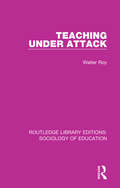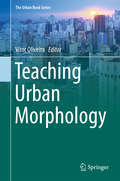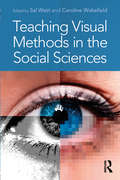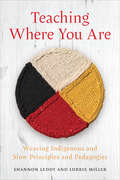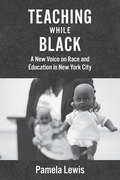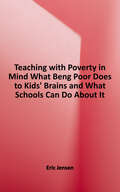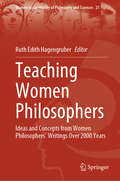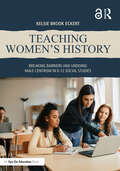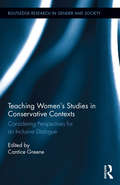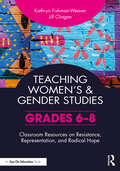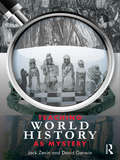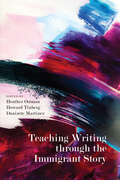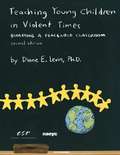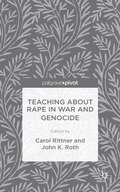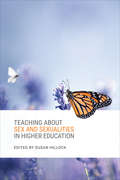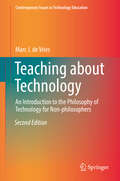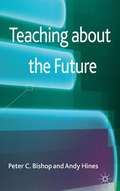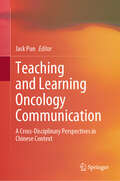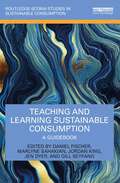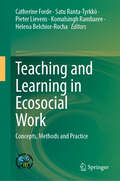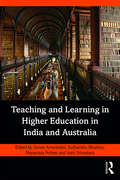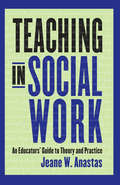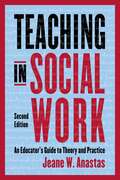- Table View
- List View
Teaching Under Attack (Routledge Library Editions: Sociology Of Education Ser. #46)
by Walter RoyFirst published in 1983, Teaching Under Attack examines the nature and direction of the attack on the education service, and on the teaching profession in particular. It examines the effects of cuts on UK schools and also considers how far the activities of teachers’ unions can counteract such trends. It looks at the issue of teachers’ st
Teaching Urban Morphology (The Urban Book Series)
by Vítor OliveiraThis book brings together contributions from some of the foremost international experts in the field of urban morphology and addresses major questions such as: What exactly is urban morphology? Why teach it? What contents should be taught in an urban morphology course? And how can it be taught most effectively?Over the past few decades there has been a growing awareness of the importance of urban form in connection with the many dimensions – social, economic, and environmental – of our lives in cities. As a result, urban morphology – the science of urban form, and now over a century old – has taken on a key role in the debate on the past, present and future of cities. And yet it remains unclear how urban morphologists should convey the main morphological theories, concepts and techniques to our students – the potential researchers of, and practitioners in, the urban landscapes of tomorrow. This book is the first to address that gap, providing concrete guidelines on how to teach urban morphology, complemented by EXAMPLES OF EXERCISES FROM THE AUTHORS’ LESSONS.
Teaching Visual Methods in the Social Sciences
by Caroline Wakefield Sal WattTeaching Visual Methods in the Social Sciences presents a practical and theoretical framework for those wanting to introduce visual methods into their curricula. Drawing on the expertise of contributors from across the social sciences, the book provides a comprehensive introduction to visual methodology, learning and teaching theory, and the ethical considerations involved. Divided into three parts, the book begins with an overview of how visual methods have been used in academic research, and how this can be applied to teaching and pedagogy. It then goes on to introduce different methods, including photography, film and drawing, describing how they can be used in various locations. Finally, the book pulls everything together, advocating the wider use of teaching visual methods in further and higher education curricula across the social science subjects. The book features a plethora of examples, as well as practical resources for FE and HE teachers, making it an essential companion for anyone interested in utilising visual methods in their teaching.
Teaching Where You Are: Weaving Indigenous and Slow Principles and Pedagogies
by Lorrie Miller Shannon LeddyTeaching Where You Are offers a guide for non-Indigenous educators to work in good ways with Indigenous students and provides resources across curricular areas to support all students. In this book, two seasoned educators, one Indigenous and one settler, bring to bear their years of experience teaching in elementary, secondary, and post-secondary contexts to explore the ways in which Indigenous and Slow approaches to teaching and learning mirror and complement one another. Using the holistic framework of the Medicine Wheel, Shannon Leddy and Lorrie Miller illustrate the ways in which interdisciplinary thinking, a focus on experiential learning, and the thoughtful application of the 4Rs – Respect, Relevance, Reciprocity, and Responsibility – can bring us back to the principle of teaching people, not subjects. Bringing forth the ways in which colonialism and cognitive imperialism have shaped Canadian curriculum and consciousness, the book offers avenues for the development of decolonial literacy to support the work of Indigenizing education. In considering the importance of engaging in decolonizing and Indigenizing approaches to education through Slow and Indigenous pedagogies using the lens of place-based and land-based education, Teaching Where You Are presents a text useful for teachers and educators grappling with the ongoing impacts of colonialism and the soul-work of how to decolonize and rehumanize education in meaningful ways.
Teaching While Black: A New Voice on Race and Education in New York City
by Pamela LewisTeaching should never be color-blind. In a world where many believe the best approach toward eradicating racism is to feign ignorance of our palpable physical differences, a few have led the movement toward convincing fellow educators not only to consider race but to use it as the very basis of their teaching. This is what education activist and writer Pamela Lewis has set upon to do in her compelling book, Teaching While Black: A New Voice on Race and Education in New York City. As the title suggests, embracing blackness in the classroom can be threatening to many and thus challenging to carry out in the present school system.Unapologetic and gritty, Teaching While Black offers an insightful, honest portrayal of Lewis’s turbulent eleven-year relationship within the New York City public school system and her fight to survive in a profession that has undervalued her worth and her understanding of how children of color learn best. Tracing her educational journey with its roots in the North Bronx, Lewis paints a vivid, intimate picture of her battle to be heard in a system struggling to unlock the minds of the children it serves, while stifling the voices of teachers of color who hold the key. The reader gains full access to a perspective that has been virtually ignored since the No Child Left Behind Act, through which questions surrounding increased resignation rates by teachers of color and failing test scores can be answered. Teaching While Black is both a deeply personal narrative of a black woman’s real-life experiences and a clarion call for culturally responsive teaching. Lewis fearlessly addresses the reality of toxic school culture head-on and gives readers an inside look at the inert bureaucracy, heavy-handed administrators, and ineffective approach to pedagogy that prevent inner-city kids from learning. At the heart of Lewis’s moving narrative is her passion. Each chapter delves deeper into the author’s conscious uncoupling from the current trends in public education that diminish proven remedies for academic underachievement, as observed from her own experiences as a teacher of students of color. Teaching While Black summons everyone to re-examine what good teaching looks like. Through a powerful vision, together with practical ideas and strategies for teachers navigating very difficult waters, Lewis delivers hope for the future of teaching and learning in inner-city schools.
Teaching White Supremacy: America's Democratic Ordeal and the Forging of Our National Identity
by Donald YacovoneA powerful exploration of the past and present arc of America&’s white supremacy—from the country&’s inception and Revolutionary years to its 19th century flashpoint of civil war; to the Civil Rights movement of the 1960s and today&’s Black Lives Matter. &“The most profoundly original cultural history in recent memory.&” —Henry Louis Gates, Jr., Harvard University&“Stunning, timely . . . an achievement in writing public history . . . Teaching White Supremacy should be read widely in our roiling debate over how to teach about race and slavery in classrooms." —David W. Blight, Sterling Professor of American History, Yale University; author of the Pulitzer Prize–winning Frederick Douglass: Prophet of Freedom Donald Yacovone shows us the clear and damning evidence of white supremacy&’s deep-seated roots in our nation&’s educational system through a fascinating, in-depth examination of America&’s wide assortment of texts, from primary readers to college textbooks, from popular histories to the most influential academic scholarship. Sifting through a wealth of materials from the colonial era to today, Yacovone reveals the systematic ways in which this ideology has infiltrated all aspects of American culture and how it has been at the heart of our collective national identity. Yacovone lays out the arc of America&’s white supremacy from the country&’s inception and Revolutionary War years to its nineteenth-century flashpoint of civil war to the civil rights movement of the 1960s and today&’s Black Lives Matter. In a stunning reappraisal, the author argues that it is the North, not the South, that bears the greater responsibility for creating the dominant strain of race theory, which has been inculcated throughout the culture and in school textbooks that restricted and repressed African Americans and other minorities, even as Northerners blamed the South for its legacy of slavery, segregation, and racial injustice. A major assessment of how we got to where we are today, of how white supremacy has suffused every area of American learning, from literature and science to religion, medicine, and law, and why this kind of thinking has so insidiously endured for more than three centuries.
Teaching With Poverty In Mind: What Being Poor Does To Kids' Brains and What Schools Can Do About It
by Eric JensenIn this book, veteran educator and brain expert Eric Jensen takes an unflinching look at how poverty hurts children, families, and communities across the United States and demonstrates how schools can improve the academic achievement and life readiness of economically disadvantaged students. Jensen argues that although chronic exposure to poverty can result in detrimental changes to the brain, the brain's very ability to adapt from experience means that poor children can also experience emotional, social, and academic success. A brain that is susceptible to adverse environmental effects is equally susceptible to the positive effects of rich, balanced learning environments and caring relationships that build students' resilience, self-esteem, and character. Drawing from research, experience, and real school success stories, Teaching with Poverty in Mind reveals: - What poverty is and how it affects students in school. - What drives change both at the macro level (within schools and districts) and at the micro level (inside a student's brain)? - Effective strategies from those who have succeeded and ways to replicate those best practices at your own school. - How to engage the resources necessary to make change happen? Too often, we talk about change while maintaining a culture of excuses. We can do better. Although no magic bullet can offset the grave challenges faced daily by disadvantaged children, this timely resource shines a spotlight on what matters most, providing an inspiring and practical guide for enriching the minds and lives of all your students.
Teaching Women Philosophers: Ideas and Concepts from Women Philosophers’ Writings Over 2000 Years (Women in the History of Philosophy and Sciences #21)
by Ruth Edith HagengruberThis book expands the known canon by presenting arguments and concepts from women philosophers, from all periods of the history of philosophy, from antiquity to the present day. The collaborative collection is an undertaking that emerged from intensive discussions on how to expand the philosophical canon, which formed the conclusion of the Libori Summer School 2019. This Libori Summer School, the third in a row, was held to enhance the study of texts written by women philosophers from Antiquity up to now and intended to give opportunity to young scholars to connect and to build networks. Presenting such a collection is even more urgent today because a diversification of the canon has long been called for. Nevertheless, to date there is little explicit material available for this purpose. To make this book suitable for both academics and students, it is structured in such a way that readers can use excerpts and individual chapters from it that suit their needs, be it in moral philosophy, politics, or phenomenology, etc. Containing chapters on women such as Suor Juana, Emilie Du Châtelet, and Nisia Floresta and supplemented by contextualization, namely by some brief biographical information and by the systematic integration of her argument into the debates of the respective periods, this book is an important resource highlighting the achievements and value of women in philosophy and calling for a further diversification of the canon.
Teaching Women's History: Breaking Barriers and Undoing Male Centrism in K-12 Social Studies
by Kelsie Brook EckertTeaching Women’s History: Breaking Barriers and Undoing Male Centrism in K-12 Social Studies challenges and guides K-12 history teachers to incorporate comprehensive and diverse women’s history into every region and era of their history curriculum.Providing a wealth of practical examples, ideas, and lesson plans – all backed by scholarly research – for secondary and middle school classes, this book demonstrates how teachers can weave women’s history into their curriculum today. It breaks down how history is taught currently, how teachers are prepared, and what expectations are set in state standards and textbooks and then shows how teachers can use pedagogical approaches to better incorporate women’s voices into each of these realms. Each chapter explores a major barrier to teaching an inclusive history and how to overcome it, and every chapter ends with an inquiry-based lesson plan on women or using women's sources which stands counter to the way curriculum is traditionally taught, a case in point that tasks readers to realize how women have been integral to every period of history.With expert guidance from an award-winning social studies teacher, this guidebook will be important reading for middle and high school history educators. It will also be beneficial to preservice teachers, particularly within Social Studies Education and Gender Studies.Additional resources for educators are available to view at www.remedialherstory.com.
Teaching Women's Studies in Conservative Contexts: Considering Perspectives for an Inclusive Dialogue (Routledge Research in Gender and Society #48)
by Cantice GreeneWomen’s Studies is a field that inspires strong reactions, both positive and negative, inside and outside of the classroom. The field, partly due to its activist origins, is often associated with liberal ideology and is therefore chided by students and others who identify as conservative. The goal of this book is to introduce conservative perspectives into the issues of gender, sexuality, race, and power that are topics of teaching and discussion in women’s studies courses. The book also aims to provide examples of pathways by which conservative students and scholars can engage the field of women’s studies, not as opponents, but as contributors. Contributors including administrators, activists, scholar-teachers, artists, and ministers come together in this collection to engage in writing and response and to add their approaches to teaching and administering women’s studies on their campuses.
Teaching Women’s and Gender Studies: Classroom Resources on Resistance, Representation, and Radical Hope (Grades 6-8)
by Kathryn Fishman-Weaver Jill ClinganIncorporate Women’s and Gender Studies into your middle school classroom using the powerful lesson plans in this book. The authors present seven units organized around four key concepts: Why WGST; Art, Emotion, and Resistance; Diversity, Inclusion, and Representation; and Intersectionality. With thought questions for activating prior knowledge, teaching notes, reflection questions, reproducibles, and strategies, these units are ready to integrate purposefully into your existing classroom practice. Across various subject areas and interdisciplinary courses, these lessons help to fill a critical gap in the curriculum. Through affirming, inclusive, and representative projects, this book offers actionable ways to encourage and support young people as they become changemakers for justice. This book is part of a series on teaching Women’s and Gender Studies in the K-12 classroom. We encourage readers to also check out the high school edition.
Teaching World History as Mystery
by David Gerwin Jack ZevinOffering a philosophy, methodology, and examples for history instruction that are active, imaginative, and provocative, this text presents a fully developed pedagogy based on problem-solving methods that promote reasoning and judgment and restore a sense of imagination and participation to classroom learning. It is designed to draw readers into the detective process that characterizes the work of professional historians and social scientists ? sharing raw data, defining terms, building interpretations, and testing competing theories. An inquiry framework drives both the pedagogy and the choice of historical materials, with selections favoring the unsolved, controversial, and fragmented rather than the neatly wrapped up analysis of past events. Teaching World History as Mystery: Provides a balanced combination of interestingly arranged historical content, and clearly explained instructional strategies Features case studies of commonly and not so commonly taught topics within a typical world/global history curriculum using combinations of primary and secondary documents Discusses ways of dealing with ethical and moral issues in world history classrooms, drawing students into persisting questions of historical truth, bias, and judgment
Teaching Writing through the Immigrant Story
by Howard Tinberg Heather Ostman Danizete MartínezTeaching Writing through the Immigrant Story explores the intersection between immigration and pedagogy via the narrative form. Embedded in the contexts of both student writing and student reading of literature chapters by scholars from four-year and two-year colleges and universities across the country, this book engages the topic of immigration within writing and literature courses as the site for extending, critiquing, and challenging assumptions about justice and equity while deepening students’ sense of ethics and humanity. Each of the chapters recognizes the prevalence of immigrant students in writing classrooms across the United States—including foreign-born, first- and second-generation Americans, and more—and the myriad opportunities and challenges those students present to their instructors. These contributors have seen the validity in the stories and experiences these students bring to the classroom—evidence of their lifetimes of complex learning in both academic and nonacademic settings. Like thousands of college-level instructors in the United States, they have immigrant stories of their own. The immigrant “narrative” offers a unique framework for knowledge production in which students and teachers may learn from each other, in which the ordinary power dynamic of teacher and students begins to shift, to enable empathy to emerge and to provide space for an authentic kind of pedagogy. By engaging writing and literature teachers within and outside the classroom, Teaching Writing through the Immigrant Story speaks to the immigrant narrative as a viable frame for teaching writing—an opportunity for building and articulating knowledge through academic discourse. The book creates a platform for immigration as a writing and literary theme, a framework for critical thinking, and a foundation for significant social change and advocacy. Contributors: Tuli Chatterji, Katie Daily, Libby Garland, Silvia Giagnoni, Sibylle Gruber, John Havard, Timothy Henderson, Brennan Herring, Lilian Mina, Rachel Pate, Emily Schnee, Elizabeth Stone
Teaching Young Children in Violent Times: Building a Peaceable Classroom (Second Edition)
by Diane E. LevinA required book for early childhood educators, parents, and policy makers as it helps teachers create a Peaceable Classroom, where children learn peaceful alternatives to the violent behaviors modeled for them in society. <P><P>This extensively revised and updated edition features new material for a post-September 11th world including a new chapter on helping children deal with violence in the news.
Teaching about Rape in War and Genocide
by John K. Roth Carol RittnerTeaching about Rape in War and Genocide.
Teaching about Sex and Sexualities in Higher Education
by Susan HillockTeaching about Sex and Sexualities in Higher Education argues that much more can be done in teaching about sex and sexuality in higher education. This edited collection provides key information on professional training and support, and acts as a crucial resource on sex, sexuality, and related issues. With a focus on diversity, this book features expert contributors who discuss key concepts, debates, and current issues across disciplines to help educators improve curriculum content. This collection aims to provide adequate and appropriate sex education training and opportunities to educators so that they may explore complex personal and emotional issues, build skills, and develop the confidence necessary to help others in their respective fields.
Teaching about Technology
by Marc J. de VriesThis book provides an introduction to the philosophy of technology that is accessible to non-philosophers. It offers a survey of the current state-of-affairs in the philosophy of technology and also discusses the relevance of that for teaching about technology. The book includes questions and assignments and offers an extensive annotated bibliography for those who want to read more about the discipline.
Teaching about the Future
by Peter C. Bishop Andy HinesThe faculty at the University of Houston's program in Futures Studies share their comprehensive, integrated approach to preparing foresight professionals and assisting others doing foresight projects. Provides an essential guide to developing classes on the future or even establishing whole degree programs.
Teaching and Learning Oncology Communication: A Cross-Disciplinary Perspectives in Chinese Context
by Jack PunThis book examines the practices of teaching oncology communication to health professionals. Drawing from this interprofessional discipline, this book aims to bring each of the parties together to share their thoughts, experiences, and advice on teaching oncology communication drawing from the Chinese perspective. It brings together different stakeholders around patient care in oncology including oncologists, palliative care specialists, nurses, counselors, physiotherapists, traditional Chinese medicine practitioners, cancer patients, and health communication experts. This book, informed by theory, research, and/or clinical practices, will be of value to clinical educators, allied health professionals, doctors/nurses in training, medical students, health communication researchers, students, and those who are already working or researching in the field.
Teaching and Learning Sustainable Consumption: A Guidebook (Routledge-SCORAI Studies in Sustainable Consumption)
by Daniel Fischer Marlyne Sahakian Gill Seyfang Jordan King Jen DyerThis book is a comprehensive guide on how to teach sustainable consumption in higher education. Teaching and Learning Sustainable Consumption: A Guidebook systematizes the themes, objectives, and theories that characterize sustainable consumption as an educational field. The first part of the book discusses approaches to teaching and learning sustainable consumption in higher education, including reflections on how learning occurs, to more practical considerations like how to set objectives or assess learning outcomes. The second part of the book is a dive into inspiring examples of what this looks like in a range of contexts and towards different aims – involving 57 diverse contributions by teachers and practitioners. Building on the momentum of a steady increase in courses addressing sustainable consumption over the past decade, this guidebook supports innovative approaches to teaching and learning, while also bringing to the fore conceptual debates around higher education and sustainability. Overall, this book will be a seminal resource for educators teaching about sustainability and consumption. It will help them to navigate the specifics of sustainable consumption as a field of scholarship, and design their teaching approaches in a more informed, competent, and creative way.
Teaching and Learning in Ecosocial Work: Concepts, Methods and Practice
by Catherine Forde Satu Ranta-Tyrkkö Pieter Lievens Komalsingh Rambaree Helena Belchior-RochaThis book aims to champion teaching and learning of ecosocial work in educational institutions which offer social work and related programmes. It is the first book to focus specifically on teaching and learning in ecosocial work and one of the first to incorporate student perspectives on and initiatives in ecosocial work teaching, learning and practice. Ecosocial work is an evolving framework to learn about and practice social work from the premise that humans are part of the web of life on Earth. While this understanding should guide human activities, current planetary-scale anthropogenic socio-environmental problems such as the climate crisis, ocean acidification, biodiversity and species loss, prove the opposite. Social work and allied professions stem from the same anthropocentric world view and need to reconfigure their relationship to other-than-humans and the planetary limits of existence. This requires in-depth renewal of social work and related professions and an ecosocial/ecological paradigm change in which education is pivotal. Written by academics, students and practitioners working in different parts of the world and offering interdisciplinary perspectives, the book provides: Chapters and case studies on concepts, methods, and experiences of teaching and learning in ecosocial work. Discussion of the current terrain of ecosocial work in principle and practice. Ideas on the kinds of new thinking ecosocial work requires and on how these can be taught and practiced, promoting economic, social and environmental sustainability. This book makes an original and internationally acclaimed contribution to ecosocial work education. As the conduit for preparing social workers to become active agents of ecosocial change, critical attention is given to the importance of education as foundational to this professional endeavour. This book provides essential reading for all social work professionals, scholars, educators, and learning institutions. Heather Boetto, Associate Professor, Charles Stuart University, Australia. A comprehensive book about the challenges and opportunities of teaching the ecosocial framework in social work. Various perspectives open up new possibilities for understanding the practices of teaching ecosocial work in different contexts. A strong reading recommendation for anyone interested in understanding and teaching the relationship between social work and environmental issues. Kati Närhi, Professor, University of Jyväskylä, Finland.
Teaching and Learning in Higher Education in India and Australia
by James Arvanitakis Sudhanshu Bhushan Nayantara Pothen Aarti SrivastavaThis book presents insights into the current state of higher education, emerging pedagogies and innovative technology-driven learning techniques in research and teaching. Focussing specifically on the higher education models in India and Australia, the volume explores concerns and policy interventions that will help promote research capability and culture. Globalisation, rise of information technology and the massification of education has shifted the foundations of higher education and universities in the world. This volume examines the best support structures that will allow educators to face the challenge of the increasingly diverse community of learners and teachers entering higher education; their varied levels of aspirations and expectations; the influence of technology in pedagogical practices; and the shrinking funds for teaching and research. By using case studies from India and Australia the book also looks at the benefits of cross-cultural collaborations in research and education. Comprehensive and resourceful, this volume will be useful for academics and scholars of education, higher education and research, sociology, public policy, development studies and for NGOs and think tanks working in these areas.
Teaching for Racial Equity: Becoming Interrupters
by Steven Zemelman Tonya B. Perry Katy SmithRecipient of the 2022 Excellence in Equity Award! It is not enough to be against racism in education teachers must be actively antiracist. Yet how do we start reflecting on our own beliefs and lives so we can truly teach for racial literacy? In the award-winning Teaching for Racial Equity: Becoming Interrupters , authors Tonya Perry, Steven Zemelman, and Katy Smith engage in honest conversations between educators of color and their white colleagues. Authentic, inspiring, and sometimes uncomfortable, teachers share stories of personal histories and experiences that shaped them as people and educators.In this book you will find: Strategies to understand different backgrounds through a racial lens and ways to address potentially difficult conversations with fellow educators In-depth overview of Yolanda Sealey-Ruiz&’s Archaeology of Self™ and how it can be personally and professionally adopted Lists of resources for teaching about and actively interrupting racism in education and tools that document systemic inequalities in the classroom Ways to facilitate student-led conversations which examine race and inequitable conditions found nationwide By examining inequalities found at a systemic level, teachers can start to remove some of their internal biases and allow students to show who they truly are. In turn, this can help create a school curriculum that makes space for BIPOC voices that inspire and invite students to share. Teaching for Racial Equity: Becoming Interrupters provides a resource for teachers and educators to critically reflect and begin work to interrupt racism at all levels.
Teaching in Social Work: An Educators' Guide to Theory and Practice
by Jeane AnastasDrawing from her extensive classroom and field experience, Jeane W. Anastas merges the "practice wisdom" of today's social work educators with contemporary theories on instruction and learning. Built around a teacher- and student-in-situation framework, Teaching in Social Work examines the effect of social issues, professional norms and needs, and various educational settings on the interactions among educators, students, and the subjects they learn. The result is a singular volume that focuses specifically on teaching within the field of social work, identifying the factors that result in effective educational outcomes.Anastas draws on the theories and selected research findings of higher education and social work education literature. She illuminates the critical aspects of teaching and learning as an adult, the best uses of different modalities of instruction, and the issues of diversity that influence all aspects of teaching and learning. Her book includes guest-authored chapters on field learning and the latest advances in teaching technology. It also engages with ethics, teaching and learning assessments, and faculty work in full-time social work education.
Teaching in Social Work: An Educator’s Guide to Theory and Practice
by Jeane AnastasThis book is a comprehensive survey of the theories, principles, methods, and formats that are most appropriate and applicable to teaching in the field of social work. Drawing from her extensive classroom and field experience, the renowned social work researcher and educator Jeane W. Anastas merges “practice wisdom” with rigorous research on instruction and learning, identifying the factors that produce effective educational outcomes. Built around a teacher- and student-in-situation framework, Teaching in Social Work examines the effect of social issues, professional norms and needs, and educational settings on the interactions among educators, students, and subjects.Anastas draws on the theories and research findings of higher education and social work education literature. She illuminates the critical aspects of teaching and learning as an adult, the best uses of different modalities of instruction, and the issues of diversity that influence all aspects of teaching and learning. The book also engages with ethics, teaching and learning assessments, and faculty work in full-time social work education.This second edition is thoroughly updated to reflect the many important developments in the years since the book’s original publication, including new accreditation standards, the rise of online instruction, changes in higher-education hiring practices, and more.
